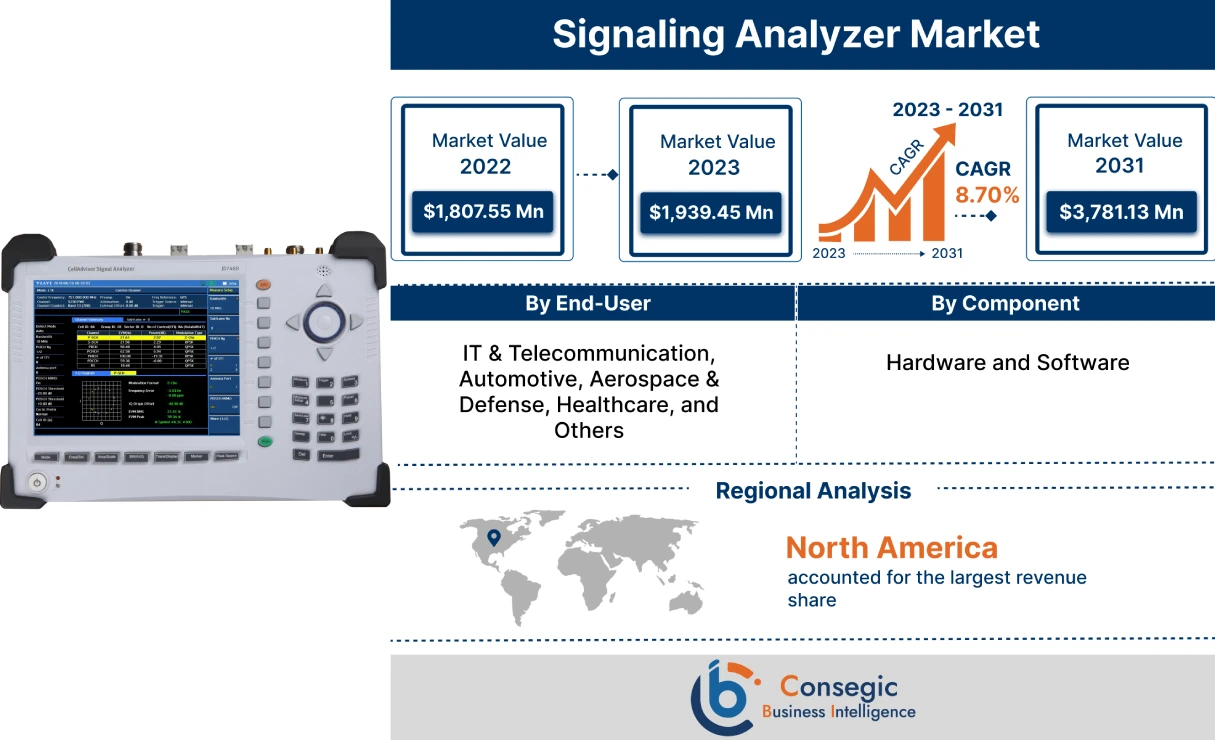Signaling Analyzer Market Introduction :
Signaling Analyzer Market is estimated to reach over USD 3,781.13 Million by 2031 from a value of USD 1,807.55 Million in 2022 and is projected to grow by USD 1,939.45 Million in 2023, growing at a CAGR of 8.70% from 2023 to 2031.
Signaling Analyzer Market Definition & Overview:
Signaling analyzers refers to an instrument that is designed for measuring the magnitude and phase of the input signal at a single frequency within the IF bandwidth of the instrument. Signaling analyzers utilize digital techniques for extraction of useful information carried by an electrical signal. Moreover, signaling analyzers are capable of functioning up to GHz range of frequency levels. Additionally, signaling analyzers have the ability to analyze signals in a faster and efficient manner while capturing phase-related information of the signal. The aforementioned characteristics of signaling analyzer are key determinants for increasing its utilization in IT & telecommunication, automotive, aerospace & defense, healthcare, and other related industries.
Signaling Analyzer Market Insights :
Signaling Analyzer Market Dynamics - (DRO) :
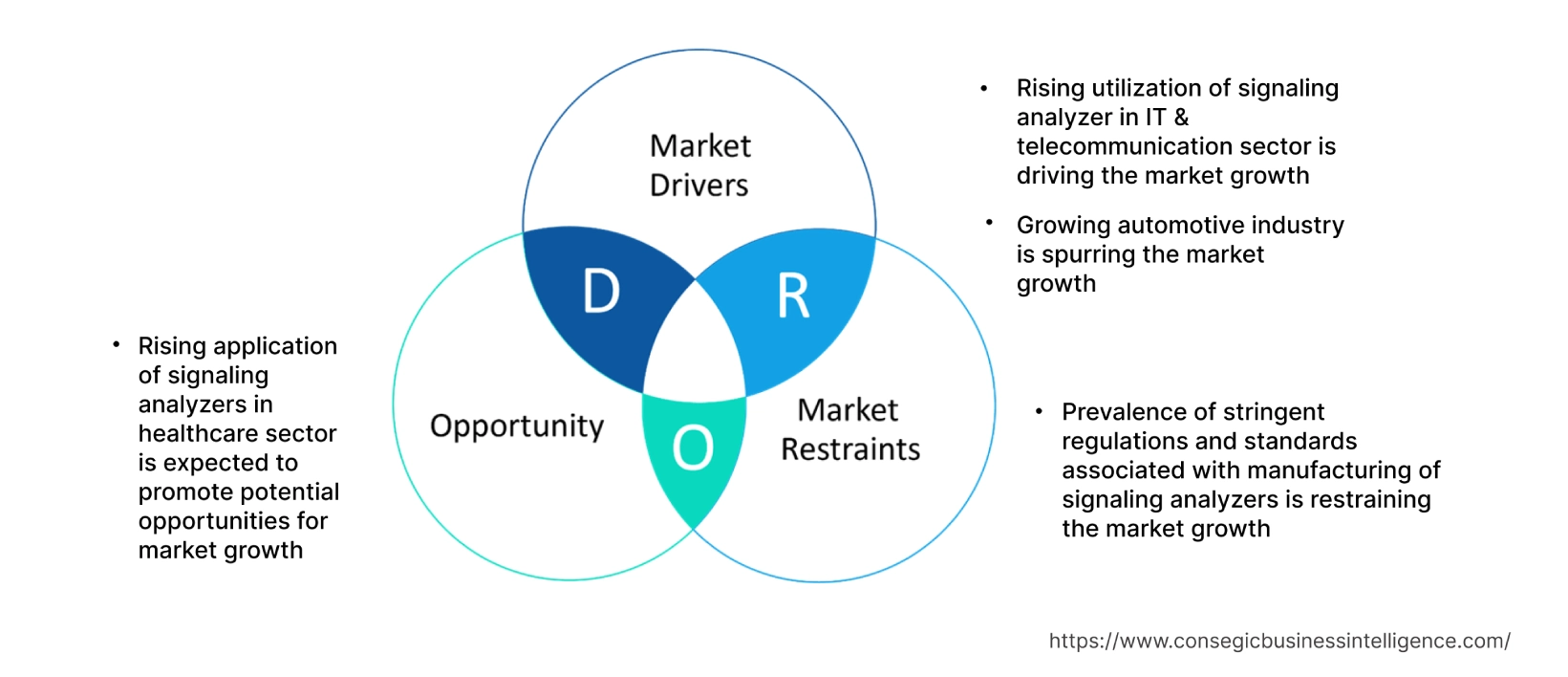
Key Drivers :
Rising utilization of signaling analyzer in IT & telecommunication sector is driving the market growth
Signaling analyzers are primarily used in the IT & telecommunication sector for troubleshooting and monitoring RF systems, including cellular communications, satellite systems, Wi-Fi networks, and radar systems among others. Signaling analyzers are also utilized for measuring the performance of RF components including amplifiers, filters, and antennas. The utilization of signaling analyzers in the IT & telecommunication sector plays a crucial role optimizing communication systems, managing traffic, and maintaining network quality.
Factors including the increasing demand for wireless communication, growing deployments of 5G infrastructure, and rising adoption of smartphones and advanced communication devices are among the vital prospects driving the growth of the IT & telecommunication industry.
For instance, according to the Ookla 5G Map, the total 5G deployments reached up to 112 countries in November 2021, witnessing an incline of 13% in comparison to 99 countries in November 2020. Additionally, according to Ookla the total 5G deployments increased considerably and reached up to 85,602 deployments in 2021 as compared to 17,428 deployments in 2020.
Thus, the growing telecommunication industry is increasing the adoption of signaling analyzers for monitoring and measuring the performance of RF systems to maintain network quality, in turn driving the growth of the market.
Growing automotive industry is spurring the market growth
Signaling analyzers are used in the automotive industry, particularly for analysis of radar signals. Signaling analyzers are used for measuring key parameters including chirp rate, length, and deviation to ensure reliable characterization of radar signals and components in order to improve the reliability of autonomous driving vehicles. Moreover, signaling analyzer offers wide range of benefits including superior RF phase noise, intermodulation suppression, high dynamic range, and others. The above benefits of signaling analyzers are key prospects increasing its utilization in the automotive sector.
Factors including advancements in autonomous driving systems, increasing production of automobiles, and rising demand for enhanced automobile safety solutions are driving the growth of the automotive industry.
According to the International Organization of Motor Vehicle Manufacturers, the total automotive production across the world reached 85.01 million in 2022, depicting an increase of 6% in contrast to 80.14 million in 2021.
Additionally, according to the European Automobile Manufacturers Association, the total passenger car production in the Europe Union reached 10.9 million in 2022, witnessing an incline of 8.3% in comparison to 2021. Therefore, the rising automobile production is increasing the utilization of signaling analyzer for automotive radar signal analysis, in turn proliferating the market growth.
Key Restraints :
Prevalence of stringent regulations and standards associated with manufacturing of signaling analyzers is restraining the market growth
Signaling analyzers are used in various industries including IT & telecommunication, automotive, aerospace & defense, healthcare and others. However, signaling analyzer manufacturers have to compulsorily comply with various stringent standards associated with the production of signaling analyzers, which is a prime factor restricting the market growth.
For instance, signaling analyzer manufacturers have to comply with various regulations and standards such as RoHS (Restriction of Hazardous Substances in Electrical and Electronic Equipment) Directive, International Electrotechnical Commission (IEC)-61010 standard, Canadian Standards Association (CSA)-C22.2 No. 61010-1, UL 61010-1 standard, and others.
The IEC 61010 standard addresses the safety of inspection, laboratory, and measurement equipment including signal analyzers. Meanwhile, UL 61010-1 and CSA-C22.2 No. 61010-1 standards ensure the safety of electrical equipment used for measurement, control, or laboratory usage.
Therefore, the prevalence of the aforementioned regulations and standards associated with the manufacturing of signaling analyzers is constraining the growth of the market.
Future Opportunities :
Rising application of signaling analyzers in healthcare sector is expected to promote potential opportunities for market growth
The rising application of signaling analyzers in the healthcare sector is expected to present potential opportunities for the growth of the signaling analyzer market. Signaling analyzers are often used in the healthcare sector, particularly in medical facilities for identifying the efficiency and performance of healthcare equipment utilizing radio frequency including MRI scanners and RFID-tagged items among others. Moreover, signaling analyzes are often used by hospital technicians for observing a wide range of radio frequency signals at a specific time frame, making it ideal for medical equipment monitoring, testing, or calibration.
Factors including the growth trend in healthcare expenditure, increasing incidence of diagnostics and surgical procedures, and rising investments in advanced medical equipment are projected to facilitate lucrative growth prospects for the market.
For instance, according to American Medical Association, the total healthcare spending in the United States reached USD 4.3 trillion in 2021, representing a growth of 2.7% in comparison to 2020. Healthcare expenditure in the United States accounted for 18.3% of the total GDP in 2021. Further, the European Commission invested approximately USD 6 billion budget during the 2021-27 period with the aim of supporting the healthcare sector in Europe.
Therefore, rising investments in healthcare sector are anticipated to increase the integration of signaling analyzers for application in medical equipment monitoring, testing, or calibration, in turn stimulating opportunities for market growth during the forecast period.
Signaling Analyzer Market Report Insights :
| Report Attributes | Report Details |
| Study Timeline | 2017-2031 |
| Market Size in 2031 | USD 3,781.13 Million |
| CAGR (2023-2031) | 8.70% |
| By Component | Hardware and Software |
| By End-User | IT & Telecommunication, Automotive, Aerospace & Defense, Healthcare, and Others |
| By Region | North America, Europe, Asia-Pacific, Latin America, and Middle East & Africa |
| Key Players | Keysight Technologies, Tektronics Inc., Viavi Solutions Inc., Anritsu Corporation, Rohde & Schwarz, National Instruments Corp., Rigol Technologies Inc., Texas Instruments, Yokogawa Electric Corporation, Advantest Corporation |
| Geographies Covered | |
| North America | U.S. Canada Mexico |
| Europe | U.K. Germany France Spain Italy Russia Benelux Rest of Europe |
| APAC | China South Korea Japan India Australia ASEAN Rest of Asia-Pacific |
| Middle East and Africa | GCC Turkey South Africa Rest of MEA |
| LATAM | Brazil Argentina Chile Rest of LATAM |
| Report Coverage | Revenue Forecast, Competitive Landscape, Growth Factors, Restraint or Challenges, Opportunities, Environment & Regulatory Landscape, PESTLE Analysis, PORTER Analysis, Key Technology Landscape, Value Chain Analysis, Cost Analysis, and Regional Trends & Forecast |
Signaling Analyzer Market Segmental Analysis :
Based on the Component :
Based on the component, the market is bifurcated into hardware and software. The hardware segment accounted for the largest revenue share in the year 2022. The primary hardware components of a signaling analyzers include RF input attenuator, mixer, IF filter, IF (Intermediate Frequency) gain, video filter, detector, sweep generator, oscillator, and CRT display among others. The hardware components enable efficient and reliable in-channel measurements including error vector magnitude that requires both phase and magnitude information.
For instance, in May 2022, Taitien Electronics launched its new ultra-low current crystal oscillators. The oscillators offer several benefits including small size, low power consumption, and high precision, along with fulfilling the signal requirements of most end equipment. Thus, the rising innovations related to hardware components used in signaling analyzers is a prime factor proliferating the growth of the segment.
The software segment is anticipated to register the fastest CAGR growth during the forecast period. The signal analyzer software is capable of computing and displaying the spectrum, and spectrogram for a wide range of signals and data types, including communication signals, bio signals, audio, and streaming data among others. Moreover, signal analyzer software enables users to control the attainment, processing, and display of the spectral content of acquired signals in order to facilitate reliable measurements and analysis. Signal analysis software also supports a broad spectrum of applications including individual signal analysis, manual signal processing, along with fully automated signal recognition and processing in wideband scenarios.
For instance, in January 2022, Tektronix Inc. released its new version of vector signal analysis software. The new version of signal analysis software introduces 5G new radio uplink/downlink measurements and analysis capabilities including error vector magnitude, channel power, occupied bandwidth, spectrum emission mask, and others. Therefore, the rising developments associated with signal analysis software is a vital factor expected to drive the growth of the market during the forecast period.
Based on the End-User :
Based on the end-user, the market is segregated into IT & telecommunication, automotive, aerospace & defense, healthcare, and others. The IT & telecommunication segment accounted for the largest revenue share of 37.6% in the year 2022. Factors including the rising penetration of 5G infrastructure, growing demand for wireless communication, and increasing demand for high-speed data and internet services are driving the growth of the IT & telecommunication segment.
For instance, Anritsu Corporation offers signal analyzer MS2850A in its product portfolio that is primarily designed for utilization in telecommunication sector for facilitating wideband communication measurements including 5G mobile communications and broadcast satellites among others.
Additionally, according to GSM Association, most of the countries in Europe deployed commercial 5G services in 2021, while two thirds of regional operators launched 5G networks. Further, 5G connections across the European region are estimated to reach 311 million by 2025. Therefore, the growth of telecommunication sector is driving the adoption of signaling analyzers for monitoring and measuring the performance of RF systems used in telecom infrastructure to maintain network quality, in turn driving the growth of the market.
The automotive segment is expected to witness the fastest CAGR growth during the forecast period. The growth of automotive segment is attributed to several factors including rising investments in expansion of automotive manufacturing facilities, increasing automobile production, and advancements in autonomous driving systems among others.
For instance, National Instruments Corp offers automotive radar signal analyzer in its product portfolio that is optimized to perform time and frequency domain analysis of frequency-modulated continuous-wave signals.
In addition, according to the China Association of Automobile Manufacturers, the total production of passenger cars in China reached up to 14.8 million units in January-August 2022, depicting a YoY growth of 14.7%. Signaling analyzers are used in the automotive industry, particularly for analysis of radar signals. Thus, rising automotive production is projected to drive the adoption of signaling analyzers, in turn contributing the market growth during the forecast period.
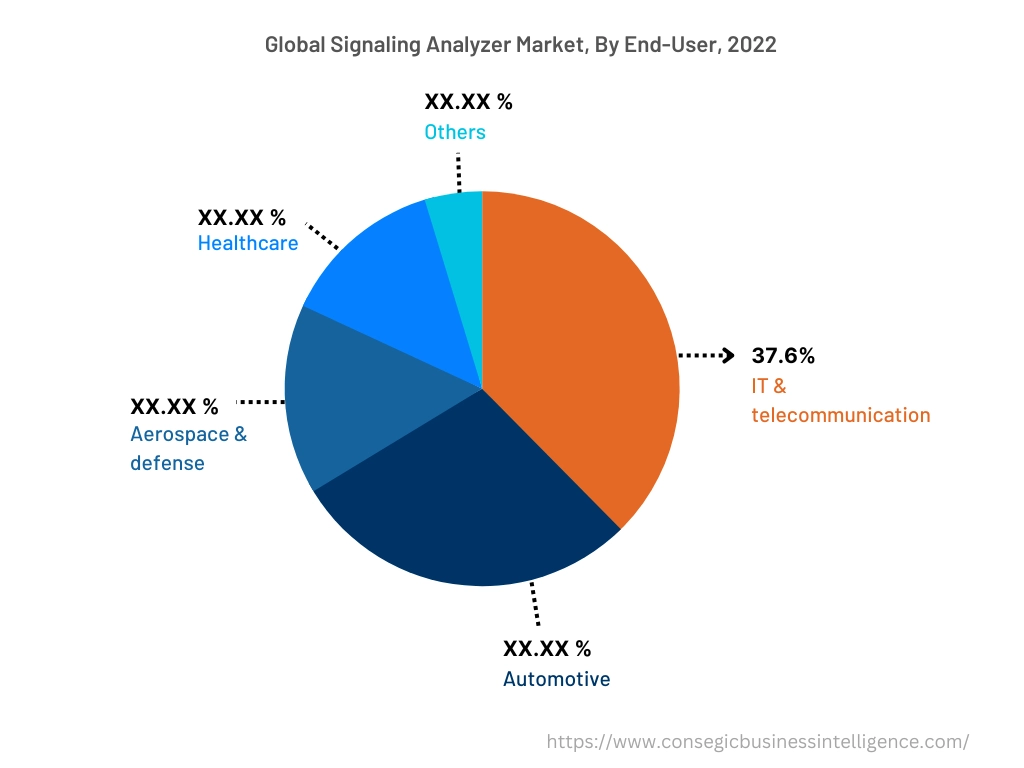
Based on the Region :
The regional segment includes North America, Europe, Asia Pacific, Middle East and Africa, and Latin America.
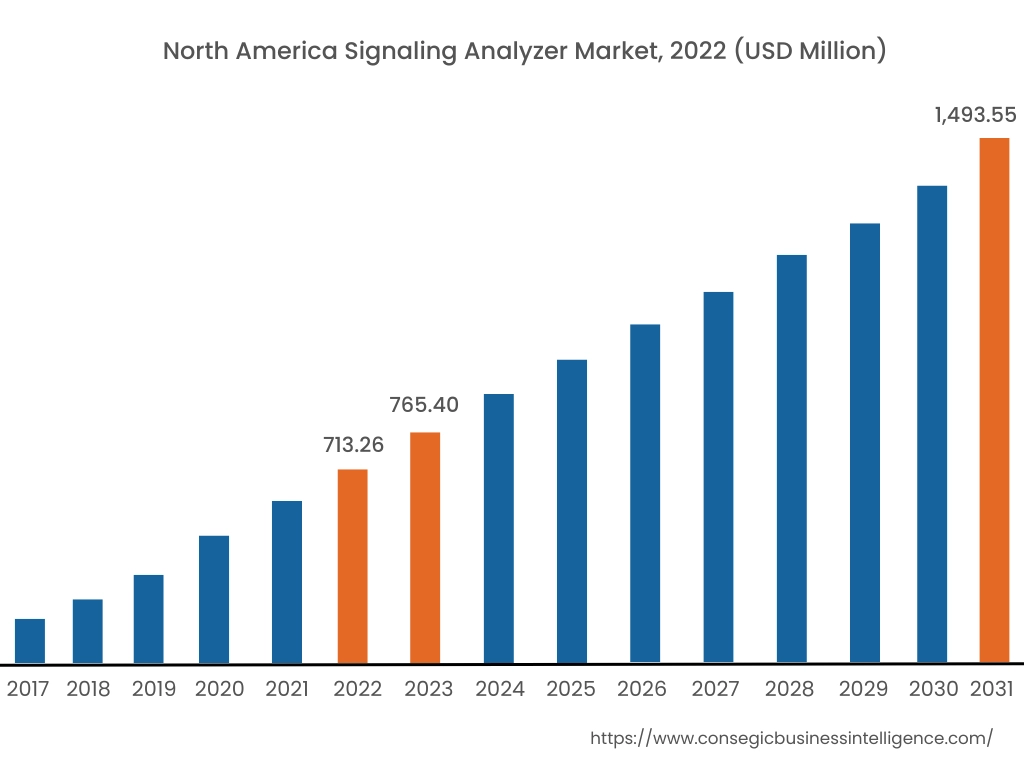
North America accounted for the largest revenue share of USD 713.26 Million in 2022 and is expected to reach USD 1,493.55 Million by 2031, registering a CAGR of 8.7% during the forecast period. In addition, in the region, the U.S. accounted for the maximum revenue share of 58.45% in the same year. The adoption of signaling analyzers in the North American region is primarily driven by its usage in IT & telecommunication, aerospace & defense, healthcare, and other sectors. Moreover, the rising utilization of signaling analyzers in telecommunication infrastructure for facilitating wideband communication measurements and analysis including 5G mobile communications are among the significant factors driving the market growth in the region.
For instance, according to the GSM Association, the deployment of 5G connections across the North American region reached approximately 140 million as of 2022. Hence, the growing telecommunication industry is fostering the utilization of signaling analyzer to ensure optimum communication and network quality, in turn driving market growth in the North American region. Further, increasing investments in healthcare and aerospace & defense industries are projected to stimulate lucrative growth prospects for the market in North America during the forecast period.
Asia-Pacific is expected to register the fastest CAGR growth of 8.9% during the forecast period. The rising pace of industrialization and development is stimulating lucrative growth aspects for the market in the region. Moreover, factors including the growth of multiple industries such as automotive, IT & telecommunication, and others are driving the market growth for signaling analyzers in the Asia-Pacific region.
For instance, according to the Society of Indian Automobile Manufacturers, the overall automobile production in India reached 2,59,31,867 units from April 2022 to March 2023, depicting an incline of 12.6% from 2,30,40,066 units from April 2021 to March 2022. Hence, the growing automotive sector is anticipated to drive the utilization of signaling analyzers for analysis of radar signals. The above factors are projected to drive market growth in the Asia-Pacific region during the forecast period.
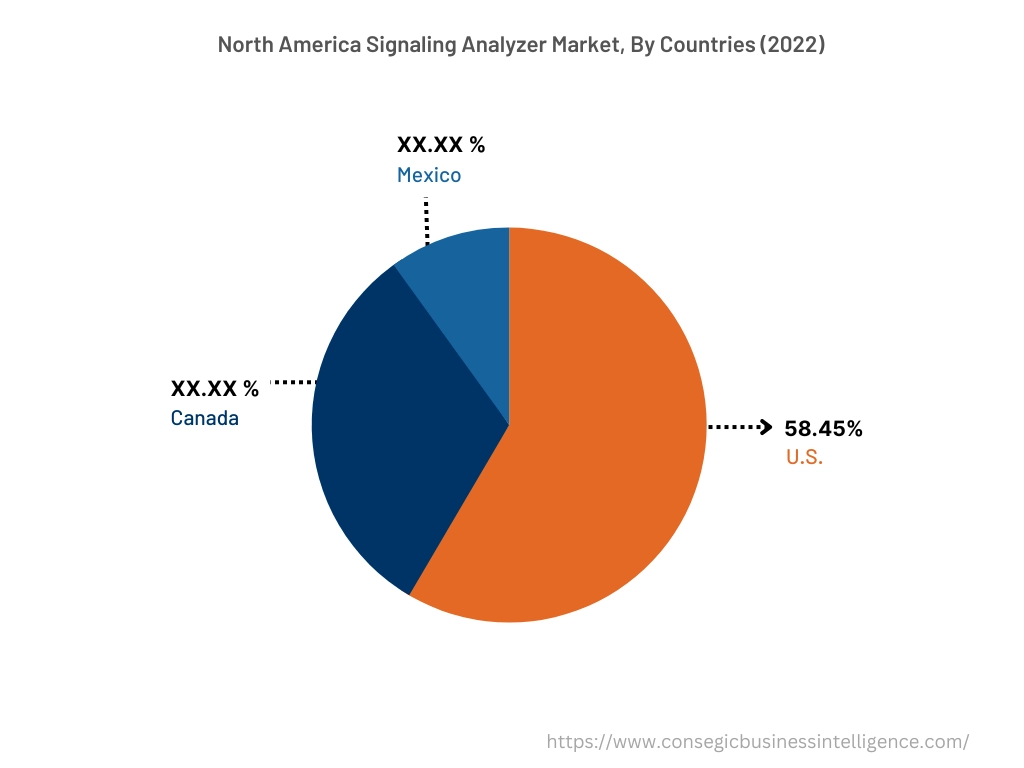
Top Key Players & Market Share Insights:
The signaling analyzer market is highly competitive with major players providing signaling analyzer to the national and international markets. Key players are adopting several strategies in research and development (R&D), product innovation, and end-user launches to hold a strong position in signaling analyzer market. Key players in the signaling analyzer market include-
- Keysight Technologies
- Tektronics Inc.
- Texas Instruments
- Yokogawa Electric Corporation
- Advantest Corporation
- Viavi Solutions Inc.
- Anritsu Corporation
- Rohde & Schwarz
- National Instruments Corp.
- Rigol Technologies Inc.
Recent Industry Developments :
- In January 2023, National Instruments Corp. launched its new high performance wideband signal analyser, PXIe-5668. The signal analyser is designed for applications including radio frequency integrated circuit characterization, wireless communications, radio detection and ranging test, along with spectrum monitoring/signal intelligence.
Key Questions Answered in the Report
What is signalling analyser? +
Signalling analysers refers to an instrument that is designed for measuring the magnitude and phase of the input signal at a single frequency within the IF bandwidth of the instrument.
What specific segmentation details are covered in the signalling analyser report, and how is the dominating segment impacting the market growth? +
For instance, by component segment has witnessed hardware as the dominating segment in the year 2022, owing to the ability of hardware components to provide efficient and reliable in-channel measurements including error vector magnitude that requires both phase and magnitude information.
What specific segmentation details are covered in the signalling analyser market report, and how is the fastest segment anticipated to impact the market growth? +
For instance, by end-user segment has witnessed automotive as the fastest-growing segment during the forecast period due to rising adoption of signalling analyser in automotive sector for radar signal analysis and measurements among others.
Which region/country is anticipated to witness the highest CAGR during the forecast period, 2023-2031? +
Asia-Pacific is anticipated to register fastest CAGR growth during the forecast period due to rapid pace of industrialization and growth of multiple industries such as automotive, IT & telecommunication, and others.
